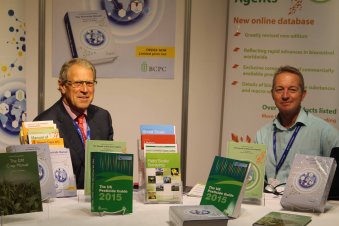
BCPC Review 2015
9th February 2016BCPC Activities and achievements in 2015
2015 has been a year of significant activity for BCPC. Highlights are described below, under titles relevant to our key outputs: Events, Publications, Opinion and Awards, with brief notes on our Partnerships and Management changes. Links are provided for those requiring further details.
To access this review as a pdf please click here.
BCPC Events
1) The 2015 BCPC Congress: EU Regulatory Affairs
Following two very successful years since the renaissance of the annual “Brighton Congress”, this year’s event, “A Positive Outlook for the Regulation of Pesticides in Europe?”, organised by BCPC in association with TSGE Forum, again took place at the Hilton Metropole, Brighton, on 6–7 October.
Representatives from EU Member State authorities in Hungary, Spain, Austria, Sweden and the UK contributed to the main regulatory sessions. These included reviews and proposals on implementation of 1107/2009; other EU regulations affecting the use of pesticides, with a session dedicated to the Water Framework Directive; outlooks for the assessment of human and environmental health; regulation of bio-stimulants; and legal highlights.
An interactive UK Chemicals Regulation Directorate (CRD) workshop, entitled “Pesticide Regulation: What are we looking for and how do we get there?”, explored expectations and needs for pesticide regulation under 1107/2009 – and CRD’s views on future developments of the regulatory regime.

BCPC Congress 2015 in full swing
For a fuller Report on the Congress, see www.bcpc.org/page_BCPC-Congress_77.html
2) BCPC Expert Working Group Reviews
BCPC Working Groups are forums where scientists and extension workers from the UK industry, research and extension institutes can meet to discuss current issues. The main outputs are invitation-only annual Reviews, targeted at those concerned with putting research findings into practice in arable agriculture and horticulture. BCPC is grateful to the research and extension institutes, agrochemical companies and contract research organisations for their kind sponsorship of our annual Reviews, as well as to the chairmen, organisers and speakers who kindly give their time and support.
The BCPC Weeds Review 2015
British farmers and growers are facing increasing problems with managing weeds, due to the rise in herbicide resistance, the decline in the number of products available and increasing environmental restrictions. Weed control used to be relatively simple and cheap – but now it isn’t. Over 80 delegates attended the 52nd BCPC Weed Review, entitled “The true costs of weed control”, at Rothamsted Research on 12 November. The Review included a popular poster session.
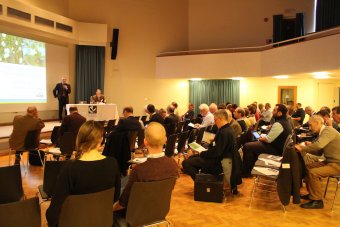 James Clarke of ADAS UK Ltd, representing the UK Weed Resistance Action Group (WRAG), gave the first presentation about thepotential for glyphosate resistance in the UK. James highlighted the risks to both arable growers and industrial/amenity users, and drew attention to the Agriculture and Horticulture Development Board (AHDB) guidance notes that users should refer to if the UK is to avoid the loss of this valuable herbicide
James Clarke of ADAS UK Ltd, representing the UK Weed Resistance Action Group (WRAG), gave the first presentation about thepotential for glyphosate resistance in the UK. James highlighted the risks to both arable growers and industrial/amenity users, and drew attention to the Agriculture and Horticulture Development Board (AHDB) guidance notes that users should refer to if the UK is to avoid the loss of this valuable herbicide
Jock Wilmott of Strutt and Parker considered the financial cost of weed control. He showed that herbicide costs (£/ha) in winter wheat and oilseed rape had doubled since 2006 due to price changes and the increased number of products used. This was mainly because of the rise in herbicide resistance in black-grass. He concluded that total fixed costs on a heavy land farm had increased by 6% – which often equated to the farmer’s profit.
One of the costs of weed control, not always adequately addressed, is the impact of farming on the wider environment. Jon Gulson of theEnvironment Agency updated the audience on the current situation regarding the presence of pesticides in surface and ground water. Pesticides comprise a small but significant number of water catchments in England and Wales. It was a concern that glyphosate and other common herbicides were also being recorded. The industry-sponsoredVoluntary Initiative (VI) is doing a lot to make farmers and growers aware of best practices but full compliance may not be achieved by these initiatives alone.
Lynn Tatnell (ADAS UK Ltd) and Mark Ballingall (SRUC) reviewed the problems of herbicide resistance in poppy, chickweed and mayweed. Although not a major problem yet, resistance to the acetolactate synthase (ALS)-inhibiting herbicides was increasing.
The declining success of weed control “from a bottle” has led to greater interest in novel and other alternative technologies. Derek Cornes ofSyngentadiscussed a range of novel techniques in development. GPS guidance and electronic control systems for both cultural and chemical application systems are already on the market, although adoption is limited to high-value crops that can justify the greater costs and where conventional herbicides are often no longer available. Similar technologies are driving forward the detection and treatment of weed patches, thus reducing the environmental footprint of herbicides.
Jim Orson (NIAB/TAG) considered the future of weed control. He suggested that “science in a bottle” would still be the backbone of conventional weed control, but that the industry needed to move towards more “sustainable intensification”, maintaining yields but reducing impacts on the environment. The key is attention to detail and for each field to be managed individually via GPS systems.
In summary, there are no single or simple solutions for weed management in the future. The cost of weed control is increasing and becoming more complex. New technologies will help, but optimising management practices and attention to detail is key to both good weed control and minimising environmental impacts. Existing products need to be handled with care to avoid more resistance and loss of any more herbicides from the marketplace.
To access the individual presentations given by the speakers at this year’s event, see www.bcpc.org/event_BCPC-Weeds-Review-2015_342.html
The BCPC Plant Diseases Review 2015
The 2nd annual Diseases Review – “Crop diseases – are we losing control?” – took place at the NIAB Park Farm, Histon, Cambridge on Thursday 3 December 2015, with over 70 delegates.
Chairman John Lucas outlined the problem. Whilst the contribution of crop protection to crop production is significant, questions are arising regarding yield plateaus, food quality, food safety and market stability. How sustainable are our current crop protection measures? Can new science counter the current disease evolutionary arms race?
Sarah Wynn (ADAS UK Ltd) reviewed the economic impact of changes to pesticide legislation, which is driving tighter standards for environmental and human health protection. This is placing increasing burdens on the possibility of products maintaining registrations and on the cost of getting new products registered, as well as the increasing cost to the grower of products per hectare. We need to consider the overall impact of any legislative changes and possible loss of products, as well as any potential mitigation actions, such as the impact on control of target diseases, the cost of crop production, quality and yield per hectare, business viability and jobs. Can products be applied differently to reduce a particular risk (e.g. low-drift nozzles)? Can industry sectors support evidence to help maintain crucial active substances? Can crops/diseases considered to be at risk be identified as research priorities? Withdrawal of a key product will inevitably mean a switch to alternative, probably less effective and inevitably more expensive products, to the point where the cost of production of a particular crop can become unprofitable. Loss of an active ingredient will also reduce the time to development of resistance to other a.i.s. Examples were presented from both agricultural and horticultural crops.
Nicola Spence (Chief Plant Health Officer, Defra) addressedemerging diseases in UK crops. Defra has a plant biosecurity strategy, which operates at pre-border, border and inland points. Defra’s UK Plant Health Risk Register takes a broad-based approach to plant health, including crops as well as natural vegetation. Examples were given of methods of entry of plants into the UK. The objectives of the Plant Health Risk Register are to identify the greatest plant health threats to crops, trees, gardens and ecosystems; and to provide a framework for decision making and priorities for action. There are currently over 800 pests identified on the risk register. Examples arePhytoplasma fragariae, normally found on strawberries but also found on hazel; Liberibacter solanacearum infecting potatoes and carrots;Fusarium oxysporum on lettuce; and Phytoplasma asteris in carrots. Whilst a disease may not be a major threat to cropping or the environment in the originating country, it may well spread onto other susceptible plant species in the UK. In the future we need a strengthened plant health regime with faster decision making and risk targeting.
Neil Paveley (ADAS) described a case study on impacts of fungicide resistance and product loss: Zymoseptoria tritici. Disease control is sustainable if we have an unlimited supply of new disease-resistance genes and fungicide modes of action (MoAs) that are accessible and safe. But we would need to introduce new disease-resistance genes and fungicide MoAs faster than pathogens can defeat them (e.g. azoles in the 1970s, strobilurins in the 1990s, new-generation succinate dehydrogenase inhibitors [SDHIs] in the 2010s).
But what is the next new MoA? Regulatory uncertainty?
What therefore should we do? Practical trade-offs could include reducing the dose (reduces efficacy) or limiting the number of treatments (constrains use of mixtures).
There is a need for another effective MoA to mix or alternate with. Knowledge gaps include use of mixtures versus alternation when there is concurrent selection for resistance against two MoAs. Which resistance-management tactics work for monocyclic pathogens? We should not change our strategy on detection of resistance; we could argue for pesticide regulation based on risk not hazard. We could implement evidence-based resistance management and fill evidence gaps (monocyclic diseases, mixtures versus alternation with concurrent selection), forecast disease to minimise selection of resistant strains, integrate chemical and genetic control, and enable high-yielding, disease resistant varieties.
James Brown (John Innes Centre, Norwich) asked can genetics mitigate the loss of fungicides against Septoria? Whereas major gene resistance does not last long, minor gene resistance lasts much longer. Farmers need adequate resistance to all major diseases in cereals. There is a trade-off between yield and Septoria resistance in breeding. Plant height contributes to lower infection even if leaves of a variety have some Septoria gene resistance, enabling them to escape infections.
The answer to the question posed is “yes, eventually”. Investment in selection needs to catch up with genetics. The current NL-rating system should encourage sustainable advances in all-round disease resistance; however, the scale should be recalibrated.
Martin MacPherson (STC) reviewed challenges in control ofBotrytis in horticulture. Key horticultural crops are grapevine, tomato (plus cucumber and pepper), strawberry and other soft- and cane-fruit crops, lettuce and other leafy salads, ornamentals, especially bedding and pot plant species, stored crops (e.g. pears, cabbage, imported crops) and seed crops.
Potential opportunities for improving Botrytis control include host crop susceptibility/resistance, pathogen (and biopesticide) epidemiology and biology, environmental management and disease forecasting, pesticides and biopesticides (formulation, dose rate, timing and application techniques), monitoring pathogen sensitivity and resistance development.
The number of a.i.s and their Fungicide Resistance Action Committee (FRAC) groups has significantly reduced in recent years, leading to a high risk of development of resistance in Botrytis. The introduction of biopesticides has not yet brought about the high levels of control required commercially.
Molecular diagnostics will change our understanding of this genus with the potential for much more complexity. Conventional chemistry is under significantly increased pressure. UK and EU legislation is increasing difficulty and costs in finding novel plant protection products (PPPs). There is greater reliance on fewer MoA groups. There is increased resistance risk and potential for crop failure, but there is little or no independent resistance monitoring being undertaken. Studies on biocontrol of Botrytis need better understanding of pathogen–parasite relationships. There is a significant need for improved coordination and support between government, legislative bodies and industry going forward, especially as food security and waste minimisation are back on the agenda.
Fiona Burnet (SRUC) considered better decision making for crop health. Why is plant doctoring not seen as a career? Scientists are rightly judged on the quality of their science through peer review of papers. We should re-attach value to the generalist and to effective decision-making.
Better links are needed between industry, scientists and teaching.Ramularia is a case study in links between infection identification, efficacy trials, core research on risk and warnings to growers, with spin out projects in industry and PhDs.
Straightforward diagnoses are only a small part of the job. A key characteristic of agricultural (or economic) policy problems is that the government, or other policy makers, have only a limited range of variables under their direct control.
Lower down the hierarchy, a myriad of decentralised decision makers – including farmers, forestry and woodland managers, smallholders, commercial nurseries and garden centres and the gardeners who use them – all make decisions that may have an impact on plant health, following a variety of behavioural rules. Good decision making in the field starts with accurate diagnosis, gathering of evidence, quantification of risk of economic damage and appraisal of options. Attitudes to risk vary; predicting disease risk properly is a science with complex methodology. By taking science into the field, we will get better evidence leading to better decision making.
To access the presentations given by the speakers at this year’s event, see www.bcpc.org/event_BCPC-Diseases-Review-2015_343.html
BCPC Pests and Beneficials
During 2015 BCPC launched this new Working Group, with enthusiastic technical membership from researchers, extension organisations, advisors and industry. On 16 February the group will deliver its first annual Review –“Can we continue to grow oilseed rape in the UK?” – where the impact of the EU neonicotinoid ban on UK oilseed rape production will be debated. See www.bcpc.org/event_BCPC-Pests-and-Beneficials-Review_355.html

BCPC Publications
1) BCPC News
This weekly publication continues to be provided free of charge as an information service from BCPC to promote the science and practice of sustainable crop production. It comprises links to current headlines, selected by our editor, to keep readers up to date with the latest news on key topics in the crop production sector.
These comprise: Ag Policy & Politics, Knowledge Transfer, Bees,Biocontrol, Bioindustry, Climate change, Environment,Food security, GM crops, Invasive aliens,Organics, Pest Control, Pesticides, Plant breeding & genetics, Soil management & fertilisers, Water & irrigation.
2) The new Pesticide Manual
The seventeenth edition of BCPC’s keynote publication – The Pesticide Manual– was published in Q4. Over the years, The Pesticide Manual has developed into an extensive database that allows users to review and contrast various pesticides. Substantially updated, this new edition contains over 862 main entries covering: herbicides, fungicides, insecticides, acaricides, nematicides, plant growth regulators, safeners, repellents, synergists, rodenticides and ectoparasiticides. It details some 45 new active ingredients which have been introduced since the previous edition.
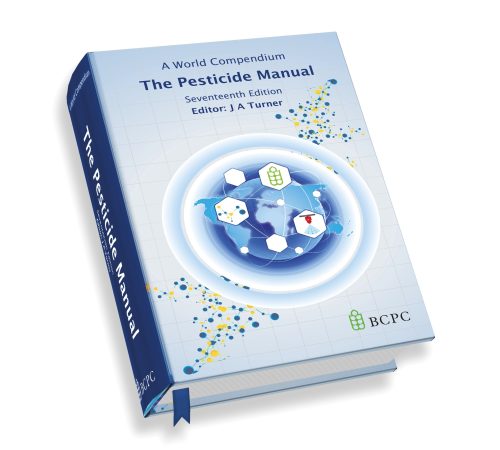 We have improved the consistency of data presentation and enhanced property comparisons. The physical chemistry section has been completely revamped, standardising units and removing extraneous information. Formats and units in the toxicology section have also been standardised, and sections separated to improve clarity. Nomenclature has been revised updating the IUPAC and CAS names to current standards. Individual components of structural or isomeric mixtures are now identified complete with names and properties associated with each entity.
We have improved the consistency of data presentation and enhanced property comparisons. The physical chemistry section has been completely revamped, standardising units and removing extraneous information. Formats and units in the toxicology section have also been standardised, and sections separated to improve clarity. Nomenclature has been revised updating the IUPAC and CAS names to current standards. Individual components of structural or isomeric mixtures are now identified complete with names and properties associated with each entity.
This edition of The Pesticide Manual will have a limited print run as it is also available as an online resource – the Online Pesticide Manual at bcpcdata.com/pm– which provides much greater utility, including user-friendly searches and retrieval of data on single or groups of pesticides. There will be a number of updates online over the next 12 months.
(Note: With the extremely fast-growing range of macro- and micro-biological organisms, botanicals and semiochemicals used in crop protection, these are now included in a separate BCPC publication –The Manual of Biocontrol Agents.)
3) Biotech Crops Info Service
With growing concerns about food security and the need to feed an expanding world population, the use of crops with novel traits has massive potential. This relatively new and complex science is developing rapidly across the world and it is important that there is an impartial, reliable and current data source.
To help meet this need, in 2015 BCPC launched a new service –Biotech Crops Info – targeted at anyone involved – or interested – in plant breeding, crop production, agronomy and biotechnology.
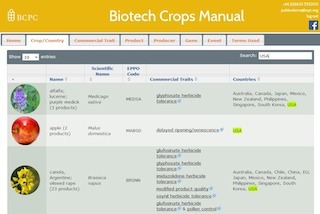 As well as conventional genetic modification technology, there are other ways in which novel traits are being introduced into crops, such as genome editing, gene suppression and other advanced breeding techniques. The Biotech Crops Manual includes all of these. Rapid growth in this sector means that an online service is the best way to provide comprehensive, up-to-date information on globally available GM products, novel traits and genome editing.
As well as conventional genetic modification technology, there are other ways in which novel traits are being introduced into crops, such as genome editing, gene suppression and other advanced breeding techniques. The Biotech Crops Manual includes all of these. Rapid growth in this sector means that an online service is the best way to provide comprehensive, up-to-date information on globally available GM products, novel traits and genome editing.
The three-tier service comprises:
- Biotech Crops Manual – a searchable database currently containing over 1,000 crops, traits and events available in global markets, with frequent updates to reflect the rapid growth in the sector
- Biotech Crops Monthly Report – an editorial report of the latest GM and novel traits developments worldwide, via email
- Biotech Crops Weekly Update – providing links to the latest plant breeding and genetics news.
The Biotech Crops Manual provides an in-depth search facility. Users can select by crop, country, trait, product, producer, gene and event code. Users can find out the global approvals, where the event can be grown, and approved uses. They can search the database and select a crop variety that not only combats the pests and diseases they wish to avoid, but that also is approved for their intended market, such as food or just feed use.
BCPC Opinion
In January 2015 BCPC responded to the European Commission Stakeholder Consultation to determine what pesticides will be considered as endocrine disruptors (EDs). Options proposed by the Commission ranged from retaining the current “interim” criteria in the Plant Protection Products Regulation (1107/2009), through to assessment of the presence of products at toxicologically relevant concentrations.
BCPC emphasised that there was no scientific justification for the current “interim criteria”, which are based on toxicological effects unrelated to an ED mode of action. A second option proposed, based on the WHO/IPCS (2002) ED definition, also considered neither the dose nor exposure. BCPC responded that regulation should not be applied without reference to the risks of adverse effects occurring in practice. The dose makes the poison; all substances, including oxygen and water, can cause adverse effects, including death, at sufficiently high doses.
The third option presented by the EU did allow assessment of whether the product might be encountered at toxicologically relevant concentrations – but does not include additional characteristics related to severity and reversibility of effect. BCPC believes that these factors, involving absorption, distribution, metabolism and excretion, should also be included in this risk assessment. Such an approach was recommended by the European Food Safety Authority (EFSA) Scientific Committee in its Scientific Opinion (March 2013) on assessment of EDs. The pharmaceutical industry operates entirely under such a risk-based assessment. If it did not, we would have no drugs at all, given their intrinsic hazards.
An October 2014 Andersons Centre report, The Effect of the Loss of Plant Protection Products on UK Agriculture and Horticulture and the Wider Economy, identified 17 leading fungicides, herbicides and insecticides that would be lost under the current “interim” ED criteria. This would in turn put greater pressure on the few remaining products, hastening resistance development. A proper risk assessment approach would prevent unnecessary bans of critical crop protection chemicals.
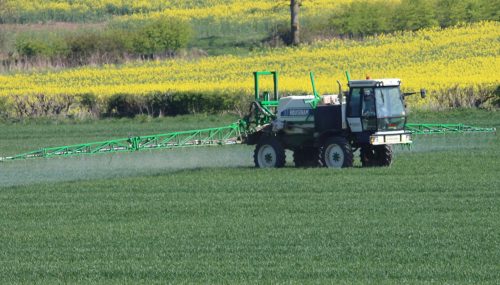 BCPC stated its concern that the current use of unscientific hazard criteria in EU pesticide legislation, rather than risk assessment, means research will be even more focused on the Americas and Asia Pacific crop protection targets. There, the science-based, more ordered and objective regulatory environment provides an innovation-conducive environment. The EU regime impacts adversely on product innovation for EU agriculture, in turn affecting competitiveness.
BCPC stated its concern that the current use of unscientific hazard criteria in EU pesticide legislation, rather than risk assessment, means research will be even more focused on the Americas and Asia Pacific crop protection targets. There, the science-based, more ordered and objective regulatory environment provides an innovation-conducive environment. The EU regime impacts adversely on product innovation for EU agriculture, in turn affecting competitiveness.
In March the EFSA published the results of its survey on pesticide residues in EU foodstuffs in 2013. EFSA’s surveys are amongst the most comprehensive worldwide; the Agency tested 81,000 samples of crops grown in, and imported into, the EU, with particular emphasis on foods where higher residues have been found in previous years. The Authority found that over 97% of samples were below maximum residue limits (MRLs), with over 50% of samples having no residues at all. There were relatively more detects in imported than in EU-produced food. Residues detects had fallen for all food products since 2010. The Authority concluded that the presence of pesticide residues in food was unlikely to have a long-term effect on consumer health.
BCPC responded that the results were very gratifying, since MRLs are a measure of residues found when pesticides are applied according to approved label rates, using good agricultural practice. They are not specific thresholds of safety concern, which can be much lower. In fact, the EFSA report shows that only 1% of samples had residues at levels where safety concerns might arise – and even these levels have safety margins built in, such as assuming that fruit is not washed or peeled, and consumed in large quantities.
Despite this encouraging picture, BCPC noted that popular media mentions of EFSA’s report continued to focus on any findings of residues. For example, fungicide residues were found in UK strawberries. This is hardly surprising; fungicides have to be used to prevent grey mould, which many consumers will remember was once a widespread cause of unacceptable deterioration of fresh strawberries.EFSA found just four instances above the MRLs for residues in UK strawberries, out of 194 samples.
The EFSA report paid particular attention to pesticides in baby foods, previously a particular cause for concern. Forty samples of “organic” baby food contained pesticide residues. Although these were at safe levels, BCPC emphasised that, contrary to popular belief, an “organic” label does not mean that no pesticides have been used. Most importantly, EFSA’s findings showed that EU farmers are very diligent in applying pesticides at approved rates of use, and that their produce is safe for EU consumers.
In July, after the International Agency for Research on Cancer (IARC)published a monograph in which glyphosate was classified as a “probable carcinogen”, BCPC pointed out that those who may feel overwhelmed by the many different arguments should remember that governments in the UK and abroad carry out rigorous tests before approving any type of plant protection product. The glyphosate furore was a good example of the sorts of issues that come up regarding pesticides. IARC assesses where there is a hazard – whether a product may cause cancer because it has that potential. But there is confusion between hazard and risk. Risk means the likelihood that harm will occur. The regulators carry out risk assessments and regulate chemicals on the basis of that risk assessment.
BCPC also explained MRLs, noting that they are a measure of what you would expect to find if proper good agricultural practice has been used. Maximum residue limits are not toxicity safety limits – just a warning sign that people have not been using a pesticide product according to its label. When pesticide residues have been found to be present in bread samples (or fresh produce), they were below toxicity levels.
See www.bcpc.org/report_Field-scale,-government-tests-can-help-to-abate-pesticide-fears_352.html
BCPC Awards
In November BCPC provided an award to the top MSc student at Harper Adams University. Aidan Thomas, 22, from Newbury, Berkshire, won the BCPC Award for his outstanding work during the MSc in Integrated Pest Management course. Aidan graduated from the Master’s course in September and is continuing at Harper Adams as a research student.
 Professor Simon Leather awarding the prize certificate to Aidan Thomas
Professor Simon Leather awarding the prize certificate to Aidan Thomas
Professor of Entomology Simon Leather said: “Aidan was an excellent student through the year, consistently scoring distinction level marks during the taught part of the course. He was awarded the MSc with Distinction. Aidan has chosen access to the online version of BCPC’sManual of Biocontrol Agents as his prize.”
BCPC Partnerships
BCPC accepted an invitation to join the Steering Group of the UK’s Voluntary Initiative (VI). In 2001, the Government accepted proposals put forward by the farming and crop protection industry to minimise the environmental impacts from pesticides. By 2006 the programme had met or exceeded the vast majority of its targets, and the VI Steering Group proposed to Ministers that the VI should continue as a rolling two-year programme. These proposals were welcomed by the Government, and the VI has continued since as a voluntary programme promoting responsible pesticide use. The independent Steering Group, under the Chairmanship of Richard Butler, directs the implementation process and reports progress to Defra Ministers.
The BCPC–VI partnership will work on a joint event to be held in 2016 to inform politicians, key opinion formers and industry leaders about the constraints UK growers face as they battle to remain profitable in an increasingly competitive and volatile global market place.
www.voluntaryinitiative.org.uk/en/home
BCPC Management
In December, BCPC was delighted to welcome Barrie Hunt – Technical Development Manager for Monsanto’s crop protection business in northern Europe – to its Board of Management. At the same time, Dr James Gilmour retired from the Board of Management, having worked with BCPC, including service on the Councils and Board, for a record 30 years. BCPC is indebted to James for all his inputs, including his tireless work on editing BCPC News and responses to consultations.

